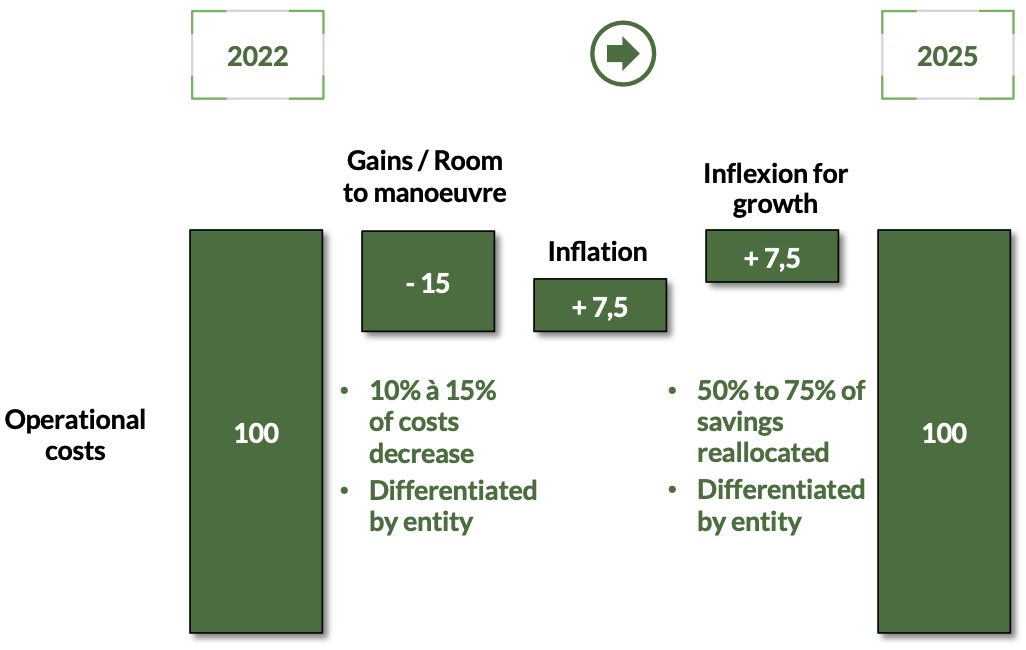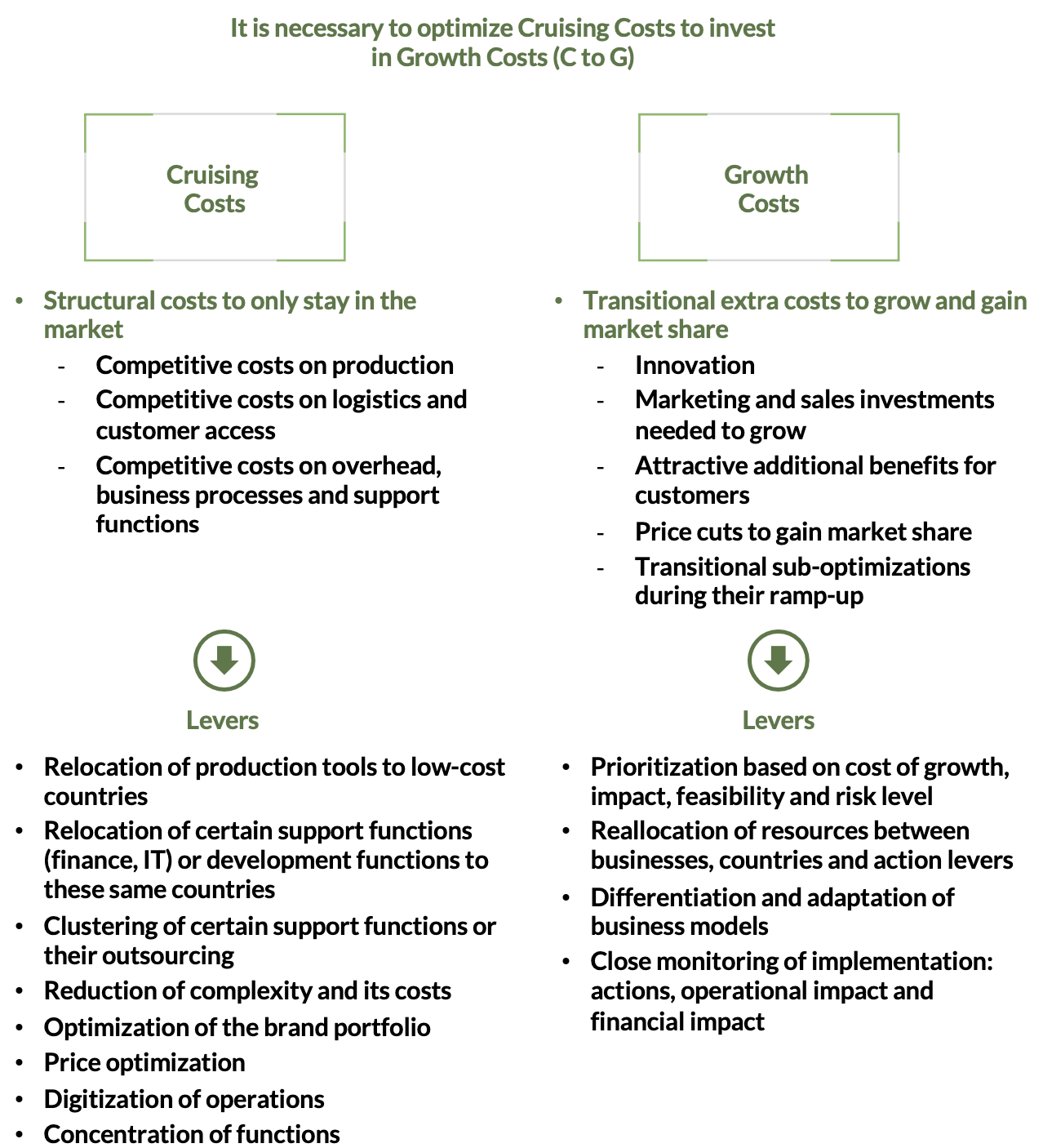Lowering Costs to Accelerate Growth

20TH February 2023
Economic downturns often highlight the obvious.
Every company must regularly adapt and reallocate its resources. It must do so not only in terms of its choice of activities, business lines, business models and geographies but also in terms of its costs. Only a significant decrease in cruising costs allows investments for growth.
Growth costs and Cruising costs (G vs. C)
Any activity is based on a mix of Growth costs, the transitory extra costs to grow and gain market share and Cruising costs, the structural costs to stay in the market.
Growth costs are the costs of innovation, of marketing and sales investments necessary to grow, of transitory sub-optimizations during their ramp-up, of the various benefits of a more attractive business model for customers, of the price cuts necessary to gain market share…
These costs must be optimized: prioritization, reallocation of resources between businesses, countries and levers of action, differentiation and adaptation of business models.
Cruising costs must be competitive and as low as possible in order to create room for maneuver and finance growth: competitive costs in production, logistics and customer access, as well as in all overheads, operating processes and support functions.
This means relocating production tools to low-cost geographies, relocating certain support functions (finance, IT) or development functions (R&D) to these same geographies, outsourcing or outsourcing certain support functions, reducing complexity and costs, optimizing the brand portfolio, optimizing prices, digitizing operations, concentrating functions…
There can be no sustainable growth if the Cruising Costs are not competitive and do not provide the necessary leeway to finance growth. It is necessary to look for all sources of efficiency and savings that will generate the additional 1 to 3 points of EBIT needed to finance the additional costs of growth.

The method for lowering costs and investing for growth
1. Define/validate management principles
A move of this magnitude must be based on solid management principles shared by senior management. These principles must define the foundations of the management approach: levers for creating corporate value, principles of delegation, principles of centralization, principles & location of autonomy, modes of transversality, links between countries and activities…
They will enable the company to build organizations, operating modes and consequently costs with a coherent guideline in relation to the strategy and coherent between the entities. They will provide a framework and boundaries for the details of implementation of approaches as well as the logic of centralization versus the logic of local adaptations.
2. Set ambitions for decrease that require the development of new approaches
Cost reallocation programs for growth must start with a global vision and management ambition before being broken down by entity and worked out at a detailed level.
The right logic for operating costs (OPEX) is generally to set an ambition of a 10% to 15% reduction and to reinvest 50% to 75% of these reductions in growth. Ultimately, the objective is to achieve stability or low growth in these costs. This approach must obviously be refined according to growth ambitions and the nature of the activities and size effects.
3. Differentiate reductions by entity and by issue
The breakdown by entity and by issue is necessary to focus efforts on the main issues while including all functions. It involves an analysis of the competitiveness of the various functions in relation to competitors and other comparable functions for certain support functions (finance, human resources, certain IT functions, etc.). In order to achieve the initial objective, it must be differentiated between reductions of 5% and 35%.
4. Differentiate investments by entity and focus on growth
All businesses need to invest in order to keep pace with changes in markets and technologies and to improve productivity. Teams also need to be reinvigorated: for operational entities, to accelerate growth; for support functions, to serve operational entities more effectively. Often, these investments are not made to the right extent because of a lack of resources.
Managers do not dare to carry out drastic reallocations within their perimeter that would allow them to do so. This movement must come from top management. At this level too, differentiation of Opex investments is necessary. Simple rules must be defined for investment priorities and returns.

For example, as a general rule, one euro of marketing and sales investment should generate 5 to 7 euros of gross margin over three to five years.
5. Launch the program at the operational team level
With solid management principles, ambitious cost reduction objectives, globally and by entity, and investment objectives globally and by entity, the teams must define a three- level action plan: breakthrough actions with new approaches to cost reduction, optimization actions and investment actions.
This action plan, quantified and defined in time, will allow to prioritize the actions in order to make them coherent from a financial point of view by prioritizing cost reductions first, plus investments and not the opposite.
What to conclude
It is necessary for a company to adapt to changes in its markets, technologies and expertise. Its survival depends on it. Nevertheless, this perspective is not enough.
It must be accompanied by an investment in activities and approaches for growth. This is why it is necessary to cover two approaches in a combined manner: costs must be reduced to give the company room to maneuver so that it can reinvest for growth, and this in a differentiated manner.
Without room to maneuver, there is no investment. Without investment, there is no growth. Without growth, there is no value creation.
Strategia Partners is a new strategy consultancy founded by Jean Berg after 30 years in Strategy consulting. It specializes in assisting Boards, CEOs, and Executive Committees of major European and North American groups in their growth strategy. Strategia Partners approach integrates three perspectives: strategic and financial performance, environmental performance, and human performance.



